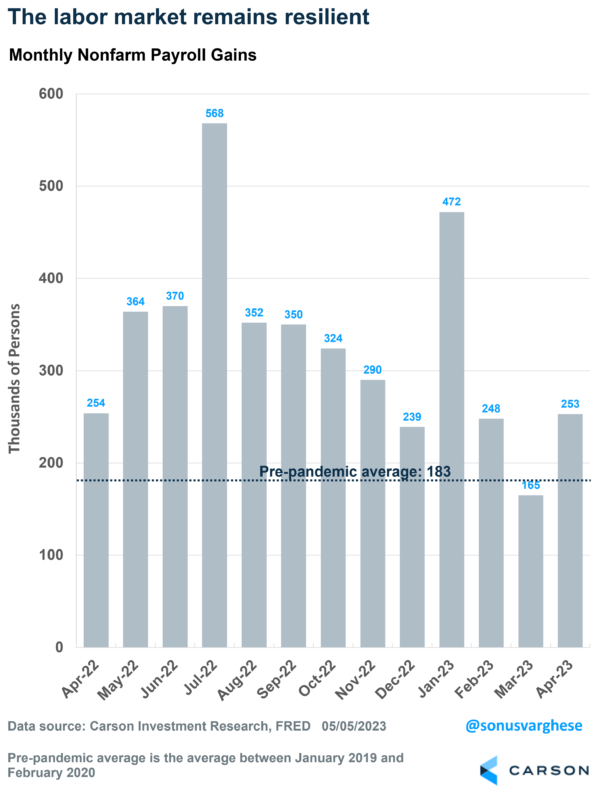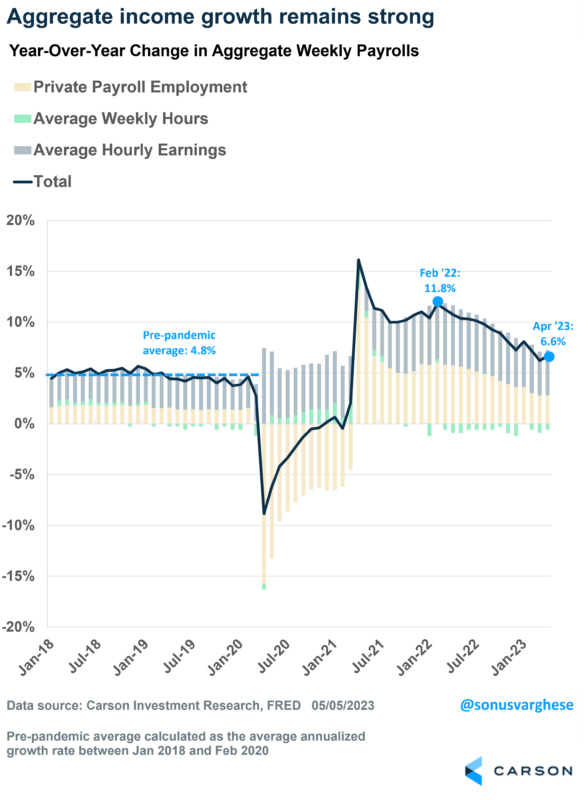If you were worried about a sudden stop for the economy on the back of a banking crisis, you may want to know that the April employment data suggests that the economy is doing just fine, perhaps more than fine. Of course, this is not to say that the banking crisis is not a problem. Banks are likely tightening credit availability but at this point, we believe it’s going to be a slow-moving adverse force on the economy.
Let’s get to the numbers, which are a big deal.

Stay on Top of Market Trends
The Carson Investment Research newsletter offers up-to-date market news, analysis and insights. Subscribe today!
"*" indicates required fields
The economy created 253,000 jobs in April, well above economists’ expectations for a 179,000 increase. Now, payroll numbers in February and March were less than what was originally reported, as they were revised down by 149,000. So, job growth in the first quarter was slightly weaker than what we thought originally.
But here’s the big picture: the economy has created more than 1.1 million jobs in the first 4 months of the year, and even if you exclude January, the last three months have averaged 222,000 jobs. That’s well above the pre-pandemic average of 183,000, which by the way, was a very strong pace.
A historically strong labor market
Any skepticism of the job creation numbers washes away when you look at the unemployment rate, which fell to 3.4%. That’s the lowest level since 1969!
I’ve written before about how the unemployment rate can be impacted by more people leaving the labor force and an aging population. One way to get around this is to look at the employment-population ratio for prime age workers, i.e., workers aged 25-54 years. This measures the number of people working as a percent of the civilian population – think of it as the opposite of the unemployment rate, and because we use prime age, you get around the demographic issue as well.
What does this mean for the Federal Reserve?
The resiliency of the job market means the Federal Reserve (Fed) is unlikely to cut interest rates any time soon.
Average hourly earnings accelerated in April, rising at a 5.9% annualized pace for all private workers. These numbers can be noisy and so it helps to look at an average, but even that is running high. Average hourly earnings have been growing at a 4.2% annualized pace over the past three months, and it’s up 4.4% over the past year. Pretty steady, but that also means the Fed will remain concerned about inflation. In their model, strong wage growth is likely to keep underlying inflation elevated.
Ultimately, the big reason for why the employment picture matters is that consumption makes up 70% of the economy. And consumption is driven by income. Overall income across the entire economy is dependent on three factors:
- Employment growth – strong
- Wage growth – strong (maybe too strong for the Fed)
- Hours worked – steady
Multiplying all three of the above gives you overall income growth across the US economy, and right now that’s up 6.6% over the past year. It’s down from about 12% in February 2022, but still above what we saw before the pandemic.
Even better news, income growth is running above inflation, which is up about 5% over the past year. And we’re continuing to see lower energy and food prices. Which means people have more money in their pockets, and that’s a good thing for this economy.
There’s no slowdown, yet. Which means the Fed is will probably keep interest rates higher for longer.
My colleague, Ryan Detrick, and I just had Sam Stovall from CFRA on our podcast this week. We talked about the economy and why its strength means the Fed is unlikely to cut rates this year.
To quote one of Sam’s rules for the stock market:
“Don’t fight the Fed, at least, for too long”
Take a listen.






